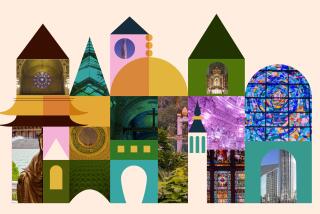Vesak Festival Celebrates Life of Buddha
- Share via
In colorful, multiethnic rites, the growing Southern California Buddhist community Sunday celebrated Buddhism’s most important holiday and sought to combat what religious leaders call misunderstanding in the Christian world, especially by the Vatican.
Buddhist clergy dressed in ceremonial robes--some in bright orange, yellow or crimson and others in black, gray or blue--chanted in seven languages outside the ornate Wat Thai Temple in North Hollywood. They gathered for the 18th annual regional observance of Vesak--the holiday recalling the birth, enlightenment and death of Gautama Buddha about 2,500 years ago.
The Venerable Havanpola Ratanasara, president of the Buddhist Sangha Council of Southern California, advised more than 200 participants to show that Buddhists are concerned about human peace, prosperity and happiness.
“We must demonstrate Buddhist values, [positive] attitudes toward social problems and virtues [of] loving kindness, compassion and equanimity,” Ratanasara said.
The Sangha Council bridges ethnic and sectarian divisions among 300 temples to organize the yearly Vesak ceremony and seeks to define U.S.-style Buddhism. The council has had formal interfaith dialogues with the Los Angeles Catholic Archdiocese since 1989 and cordial interfaith contacts much longer.
But relations became tense in late March when Cardinal Joseph Ratzinger, the Vatican’s chief guardian of doctrine, repeated an earlier prediction that Buddhism, which he called “an erotic spirituality,” would replace Marxism as the church’s greatest challenge by 2000.
“If Buddhism seduces,” Ratzinger told a French newspaper, “it is because it seems possible to reach the boundless and the bliss without having concrete religious obligations.”
The cardinal’s critique contrasts with the relative admiration by U.S. Catholic leaders. A U.S. bishops committee extended official Vesak greetings to American Buddhists this spring while also apologizing for Catholic comments on Buddhism that had offended Buddhists in the past.
In his 1994 book, “Crossing the Threshold of Hope,” Pope John Paul II called Buddhism a “negative” system that “offers a doctrine of salvation that seems increasingly to fascinate many Westerners as an ‘alternative’ to Christianity or as a sort of ‘complement’ to it.”
During his tour of Asian and Pacific island countries, the pope tried to make amends by proclaiming his “profound respect and sincere esteem” for Buddhism. But six Buddhist leaders refused to meet with him in Sri Lanka on the final stop of that tour.
Last summer, Buddhist-Catholic relations received a boost at a Trappist monastery in Kentucky where Buddhists, including the Dalai Lama, met with Catholic priests who have studied Buddhist teachings and practices as inspired by the late Trappist monk Thomas Merton.
On Sunday, Ratanasara said local Buddhists “are not angry” about past Vatican statements. Some high Catholic officials “are guided by old, outdated writings about Buddhism that are found in Europe,” said Ratanasara, a native of Sri Lanka who also heads the American Buddhist Congress.
Another Buddhist Congress official, Korean minister Henry S. Shinn of Redlands, expressed hope that the Buddhist ideals of compassion for others and greater Buddhist unity would someday lead to Buddha’s birthday becoming a national holiday like Christmas.
Japanese Buddhists celebrate Buddha’s birthday on April 8, and most other Buddhists observe Vesak, also written Wesak or Visakha, around the time of May’s full moon--May 22 this year. The Sangha Council marks the holiday early to avoid conflict with local temple celebrations.
In a display of unity, Japanese Buddhists have joined the Vesak rites for the last four years.
At the end of the ceremony Sunday, monks of various traditions took turns “bathing the baby Buddha” by pouring honey over a small figure of the religion’s founder--a ritual in Japanese Buddhism not usually performed in other ethnic traditions.
The birth and death dates given for Gautama Buddha differ also. In Sri Lanka and Southeast Asia the life of the Buddha is dated from 624 to 544 B.C., but northern traditions say it was 448 to 368 B.C. Scholars settle on a period in the middle, according to the HarperCollins Dictionary of Religion.
Although Buddhism arrived in America a century ago, its organized presence in Southern California was negligible before the Los Angeles-based Sangha Council formed in 1980.
American converts to Buddhism carry a special burden to explain the beliefs and practices of the ancient Eastern religion, said the Rev. Sama Dede Whiteside, who took part in the English-chant portion of the ceremony Sunday.
“Unlike many of our teachers who were born overseas, we understand American culture,” said Whiteside, a convert who belongs to a Sri Lankan temple in Los Angeles’ Crenshaw District.
More to Read
Sign up for Essential California
The most important California stories and recommendations in your inbox every morning.
You may occasionally receive promotional content from the Los Angeles Times.













